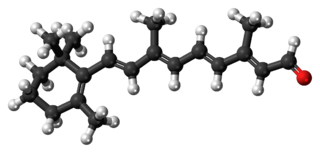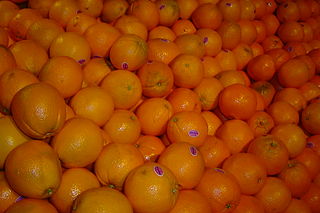Related Research Articles

Vitamin A is a group of unsaturated nutritional organic compounds that includes retinol, retinal, retinoic acid, and several provitamin A carotenoids. Vitamin A has multiple functions: it is important for growth and development, for the maintenance of the immune system, and for good vision. Vitamin A is needed by the retina of the eye in the form of retinal, which combines with protein opsin to form rhodopsin, the light-absorbing molecule necessary for both low-light and color vision. Vitamin A also functions in a very different role as retinoic acid, which is an important hormone-like growth factor for epithelial and other cells.

Retinol, also known as Vitamin A1, is a vitamin found in food and used as a dietary supplement. As a supplement it is used to treat and prevent vitamin A deficiency, especially that which results in xerophthalmia. In regions where deficiency is common, a single large dose is recommended to those at high risk a couple of times a year. It is also used to reduce the risk of complications in those who have measles. It is used by mouth or injection into a muscle.

Carotenoids, also called tetraterpenoids, are yellow, orange, and red organic pigments that are produced by plants and algae, as well as several bacteria, and fungi. Carotenoids give the characteristic color to pumpkins, carrots, corn, tomatoes, canaries, flamingos, salmon, lobster, shrimp, and daffodils. Carotenoids can be produced from fats and other basic organic metabolic building blocks by all these organisms. The only land dwelling arthropods known to produce carotenoids are aphids, and spider mites, which acquired the ability and genes from fungi., It is also produced by endosymbiotic bacteria in whiteflies. Carotenoids from the diet are stored in the fatty tissues of animals, and exclusively carnivorous animals obtain the compounds from animal fat. In the human diet, absorption of carotenoids is improved when consumed with fat in a meal. Cooking carotenoid-containing vegetables in oil increases carotenoid bioavailability.

Among animals which produce eggs, the yolk is the nutrient-bearing portion of the egg whose primary function is to supply food for the development of the embryo. Some types of egg contain no yolk, for example because they are laid in situations where the food supply is sufficient or because the embryo develops in the parent's body, which supplies the food, usually through a placenta. Reproductive systems in which the mother's body supplies the embryo directly are said to be matrotrophic; those in which the embryo is supplied by yolk are said to be lecithotrophic. In many species, such as all birds, and most reptiles and insects, the yolk takes the form of a special storage organ constructed in the reproductive tract of the mother. In many other animals, especially very small species such as some fishes and invertebrates, the yolk material is not in a special organ, but inside the egg cell (ovum).

β-Carotene is an organic, strongly colored red-orange pigment abundant in plants and fruits. It is a member of the carotenes, which are terpenoids (isoprenoids), synthesized biochemically from eight isoprene units and thus having 40 carbons. Among the carotenes, β-carotene is distinguished by having beta-rings at both ends of the molecule. β-Carotene is biosynthesized from geranylgeranyl pyrophosphate.

Abscisic acid (ABA) is a plant hormone. ABA functions in many plant developmental processes, including seed and bud dormancy, the control of organ size and stomatal closure. It is especially important for plants in the response to environmental stresses, including drought, soil salinity, cold tolerance, freezing tolerance, heat stress and heavy metal ion tolerance.

Retinal, also known as retinaldehyde, is a form of vitamin A. It was originally called retinene, and renamed after it was discovered to be vitamin A aldehyde. Retinal is one of the many forms of vitamin A. Retinal is a polyene chromophore, bound to proteins called opsins, and is the chemical basis of animal vision. Retinal allows certain microorganisms to convert light into metabolic energy.
The ionones are a series of closely related chemical substances that are part of a group of compounds known as rose ketones, which also includes damascones and damascenones. Ionones are aroma compounds found in a variety of essential oils, including rose oil. β-Ionone is a significant contributor to the aroma of roses, despite its relatively low concentration, and is an important fragrance chemical used in perfumery. The ionones are derived from the degradation of carotenoids.

Lutein is a xanthophyll and one of 600 known naturally occurring carotenoids. Lutein is synthesized only by plants, and like other xanthophylls is found in high quantities in green leafy vegetables such as spinach, kale and yellow carrots. In green plants, xanthophylls act to modulate light energy and serve as non-photochemical quenching agents to deal with triplet chlorophyll, which is overproduced at very high light levels, during photosynthesis. See xanthophyll cycle for this topic.

Zeaxanthin is one of the most common carotenoid alcohols found in nature. It is important in the xanthophyll cycle. Synthesized in plants and some micro-organisms, it is the pigment that gives paprika, corn, saffron, wolfberries, and many other plants and microbes their characteristic color.
Cyanogen bromide is the inorganic compound with the formula (CN)Br or BrCN. It is a colorless solid that is widely used to modify biopolymers, fragment proteins and peptides, and synthesize other compounds. The compound is classified as a pseudohalogen.

Carotenoid oxygenases are a family of enzymes involved in the cleavage of carotenoids to produce, for example, retinol, commonly known as vitamin A. This family includes an enzyme known as RPE65 which is abundantly expressed in the retinal pigment epithelium where it catalyzed the formation of 11-cis-retinol from all-trans-retinyl esters.

Biological pigments, also known simply as pigments or biochromes, are substances produced by living organisms that have a color resulting from selective color absorption. Biological pigments include plant pigments and flower pigments. Many biological structures, such as skin, eyes, feathers, fur and hair contain pigments such as melanin in specialized cells called chromatophores. In some species, pigments accrue over very long periods during an individual's lifespan.

Blakeslea trispora is a mould and member of the division Zygomycota. This species has been well studied for its ability to produce carotenoids, particularly, β-carotene and lycopene. β-carotene is a vitamin A precursor and both of β-carotene and lycopene play a significant role in the inhibition of oxidative stress. Blakeslea trispora is commonly isolated from soil samples throughout the Southern United States and Southern Asia. B. trispora is a pathogen of tropical plants. In vivo pathogenicity testing using animal models suggests this fungus is not a cause of animal or human disease.

The Cara Cara navel orange, or red-fleshed navel orange, is an early-to-midseason navel orange believed to have developed as a spontaneous bud mutation on a Washington navel orange tree.

Damascenones are a series of closely related chemical compounds that are components of a variety of essential oils. The damascenones belong to a family of chemicals known as rose ketones, which also includes damascones and ionones. beta-Damascenone is a major contributor to the aroma of roses, despite its very low concentration, and is an important fragrance chemical used in perfumery.

Salmon is a common food classified as an oily fish with a rich content of protein and omega-3 fatty acids. In Norway – a major producer of farmed and wild salmon – farmed and wild salmon differ only slightly in terms of food quality and safety, with farmed salmon having lower content of environmental contaminants, and wild salmon having higher content of omega-3 fatty acids.
Torulene dioxygenase (EC 1.13.11.59, CAO-2, CarT) is an enzyme with systematic name torulene:oxygen oxidoreductase. This enzyme catalyses the following chemical reaction
Ether cleavage refers to chemical substitution reactions that lead to the cleavage of ethers. Due to the high chemical stability of ethers, the cleavage of the C-O bond is uncommon in the absence of specialized reagents or under extreme conditions conditions.
Jagannath Ganguly (1921–2007) was an Indian biochemist known for his researches on Vitamin A and fatty acids, which assisted in the better understanding of their metabolism in humans. Born on the 1 April 1921, he authored a book, Biochemistry of Vitamin A, which details the physiological, biochemical and nutritional characteristics of the organic compound. The Council of Scientific and Industrial Research, the apex agency of the Government of India for scientific research, awarded him the Shanti Swarup Bhatnagar Prize for Science and Technology, one of the highest Indian science awards, in 1963, for his contributions to biological sciences. He died on 12 December 2007.
References
- ↑ Marasco, Erin K.; Vay, Kimleng; Schmidt-Dannert, Claudia (2006). "Identification of Carotenoid Cleavage Dioxygenases from Nostoc sp. PCC 7120 with Different Cleavage Activities". Journal of Biological Chemistry. ASBMB. 281 (42): 31583–31593. doi: 10.1074/jbc.M606299200 . PMID 16920703.